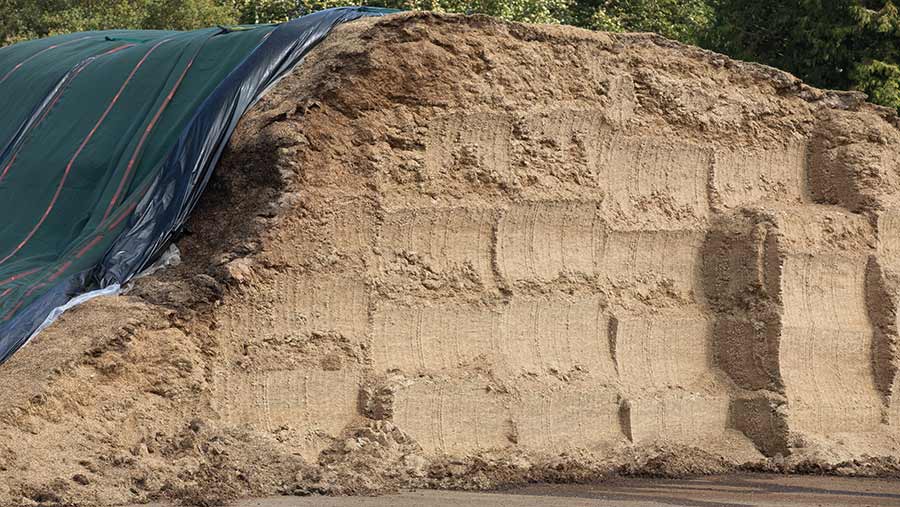5 key ways to optimise maize feeding
 © Tim Scrivener
© Tim Scrivener Harvesting, clamping and feeding maize correctly can improve winter nutrition and reduce potential health hazards
Animal feed expert, Prof Mike Wilkinson of University of Nottingham, offers advice on how to optimise feeding out to boost milk yields while safeguarding animal health.
He shared five key points on how to optimise feeding out:
1. Feed out rapidly
Losses shoot up if feed-out rates are slow. Research work has shown that allowing feed-out rates to drop below 1m/week through the winter, increases dry matter (DM) losses especially at low bulk densities.
As much as 24% of DM was lost in densities of 481kg/cu m. Even very dense clamps at 961kg/cu m still lost 6% DM. However, when feed-out rates exceeded 1.5m/week, losses across all crop densities fell to less than 3% DM.
See also: Why structural fibre is essential for fresh cows
2. Throw away rubbish
Any silage that is off-smelling, discoloured or mouldy should be thrown away. Don’t be tempted to feed heated, poor quality silage to dry cows and youngstock. These animals have lower immunity than lactating cows and the silage can contain high levels of mycotoxins.
3. Test
Tests cost only about £15/sample, yet a monthly assessment can provide invaluable information. Sampling can identify considerable variations in feed quality that can be addressed by reworking rations before milk yields are affected.
4. Maize inclusion rates
It is possible to have relatively high levels of maize forage, provided there are sources of chewable fibre and degradable protein in the diet. Prof Wilkinson highlighted the Nottingham diet fed to cows on the Sutton Bonington Dairy Unit (see table below).
The ration produced yields of 12,717 litres a cow, at 40.2 litres/day, 3.81% fat and 3.27% protein.
Total mixed ration at Sutton Bonington Dairy Unit |
|
|
Total mixed ration components |
Kg freshweight a head a day |
|
Maize silage |
20 |
|
Wholecrop |
10 |
|
Grass silage |
8 |
|
Treated straw |
0.5 |
|
Soya/rapemeal |
4.1 |
|
Molasses |
1 |
|
Fats |
0.4 |
|
Minerals |
0.3 |
|
Urea |
0.075 |
|
Yeast and binder |
0.05 |
|
Total |
44.43 |
|
Water |
3 |
5. Compact total mixed ration
The main aim of a compact total mixed ration (TMR) is to prevent sorting by binding the ration ingredients using water. While a conventional TMR has a DM of about 50%, a compact TMR is typically 36-38% DM, achieved by soaking concentrates.
Trials of a compact versus conventional TMR conducted at Llysfasi College in Wales increased milk yields by 1.6 litres/day. Milk fat was also raised to 4.15% on the compact TMR compared with 4.05% on the conventional ration.
The diet was 70% grass silage and 30% concentrate, fed at 4.5kg a head. Dry feeds were soaked overnight in 8 litres of water a cow, then mixed for 30 minutes.
Fibre intake and acidosis
Acidosis is caused by concentrate – either due to an excess in the diet or through sorting.To offset the risk, it is important to encourage saliva production which neutralises the acid in the rumen.
To gauge the level by eye, a cow should chew a mouthful of feed 50-60 times when she is ruminating sufficiently. Further checks can be carried out on the feed itself by ensuring there is enough chewable material of +8mm long by sieving the TMR.
While fibre is important, there is an optimal level that needs to be considered. Too much neutral detergent fibre (NDF) and the animal gets full up, intakes fall and so do milk yields, said Prof Wilkinson.
Optimal fibre intake is, therefore, 1.2% of the cow’s bodyweight – so for a 700kg animal, this would equate to 8.4kg/day of NDF.
